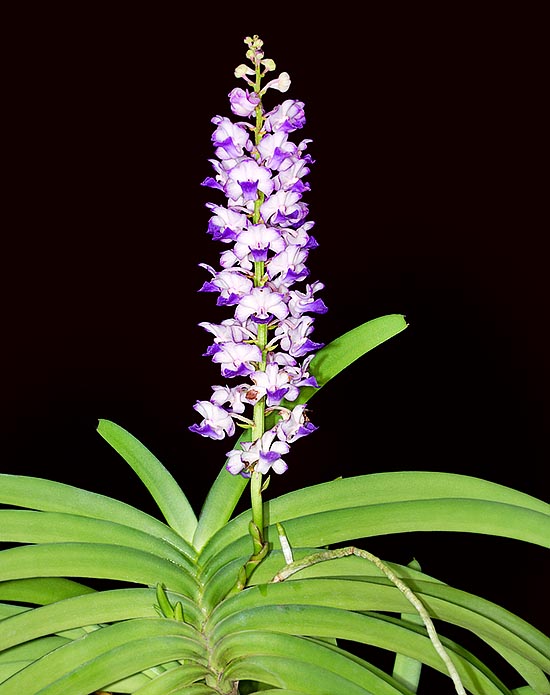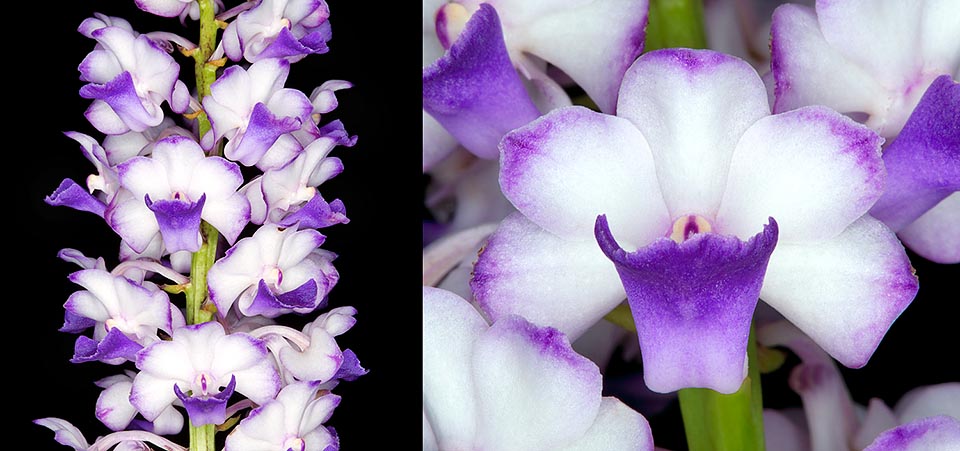Family : Orchidaceae

Text © Pietro Puccio

English translation by Mario Beltramini

Native to Cambodia, Thailand and Viatnam, the Rhynchostylis coelestis is a 25-30 cm epiphyte with solid aerial roots and 10-20 cm alternate imbricate luxuriant leaves © Giuseppe Mazza
The name of the genus is the combination of the Greek terms “ρύγχος” (rhynchos) = beak and “στῦλος” (stylos) = column with reference to the shape of the column of the type species; the name of the species is the Latin adjective “coelestis, e” = light blue, with reference to the colour of the flowers.
Common names : khao kae (Thai); lan ngọc điểm hải âu (Vietnamese).
The Rhynchostylis coelestis (Rchb.f.) A.H.Kent (1891) is a 25-30 cm tall monopodial epiphytic orchid with erect stem hidden by the foliar bases, of about 1 cm of diameter, with long and robust aerial roots and alternate distichous leaves, imbricate, oblong-linear with irregularly bilobed apex, curved, 10-30 cm long and 1,5-2,5 cm broad, thick and coriaceous, of intense green colour with pale green longitudinal striations.
Lateral inflorescences, racemose, erect, compact, up to about 30 cm long, bearing up to more than 50 flowers of 1,5-2 cm of diameter, waxy, of white colour with violet blue shades at the apex of sepals and petals and a spot of the same colour on the labellum, it does also exist with wholly white flowers.
Sepals and petals are similar, obovate, about 0,7 cm long, the lateral sepals are merged at the base of the column to form a short curved spur (mentum), the apex of the labellum bends brusquely upwards. The long-lasting flowers, 2-3 weeks, emit a pleasant delicate scent.
It reproduces by seed, in vitro, by micropropagation and through the lateral ramifications it may produce.
Very ornamental species that has originated several hybrids, requires high luminosity, medium-high temperatures in summer, with daily values of 24-35 °C and night ones preferably of 18-22 °C, slightly cooler in winter with night lowest not under the 14 °C, high humidity, 80-85% in summer and early autumn, less, 60-70%, in winter and spring; the ventilation must be constant all year round.
During the growth to give water and nebulize even daily, in particular the plants cultivated with bare roots, in the morning in way that they are dry by the evening and there is no water stagnating in the axil of the leaves, cause of easy rottenness, to reduce the waterings when the roots stop in growing. Waterings and nebulizations must be done with rainwater, demineralized or by reverse osmosis, and the fertilizations, every 2-3 weeks during the period of growth, with balanced products, with microelements, at half the dosage shown on the package.

The showy inflorescences easily reach 30 cm with more than 50 flowers of 1,5-2 cm of diameter. They are waxy, scented and last even 3 weeks. Several hybrids © Giuseppe Mazza
The roots do not love being disturbed, therefore the repottings are to be done when strictly necessary, in the case of plants with bare root, the basket may be simply transferred into a bigger one.
The species is reported in the appendix II of the CITES (species whose trade is internationally ruled).
Synonyms : Saccolabium coeleste Rchb.f. (1885); Vanda pseudocaerulescens Guillaumin (1930).
→ For general notions about ORCHIDACEAE please click here.
